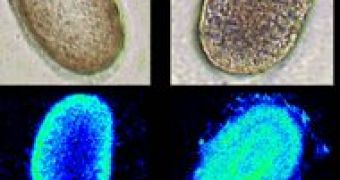A hair-dye formula used 2000 years ago by Greeks and Romans works by causing tiny nanocrystals to form deep inside layers of hair fiber.
Ancient Egyptians already used cosmetics thousands of years before, where lead compounds were applied as foundation or eye makeup.
A hair-dye recipe described in Greco-Roman times involves applying a paste of lead oxide and lime (calcium hydroxide) to graying and fair hair.
Repeated applications of this formula darken the hair as much as desired.
The lead-lime mix reacts with sulfur present in hair's keratin proteins to form crystals of galena (lead sulfide).
A team that included investigators from the Center for Research and Restoration of the Museums of France (C2RMF) and L'Or?al Research, soaked blond hairs in a solution of the Greco-Roman formula for up to three days to see how tiny and penetrating the galena crystals are.
Once the desired dark coloration was achieved, the team examined them under an electron microscope.
The hair layers were filled through with lead-sulfide crystals averaging 4.8 nanometers in size, about the same as the so-called quantum dots studied by researchers today.
The crystals formed strings down the length of the hair fiber.
Because of the spacing of these strings and chemical changes to the hair, the crystals apparently grow among the sulfur-rich amino acids from the keratin microfibers.
"It is remarkable that the composition and supramolecular organization of keratins can control PbS [lead-sulfide] nanocrystal growth inside a hair," said Phillipe Walter from French Museums' Research and Restoration Center in Paris Philippe Walter, lead author of the study, suspects nanocrystals are also at work.
"Such lead-based dyes don't seem to be harmful," he notes, "because they have trouble penetrating the skin."
A hair-like scaffold could be used to grow "quantum dots" - tiny crystals which confine a handful of electrons in a way that makes it possible to exploit their quantum properties, such as spin, for use in emerging quantum computing systems. Present methods for producing quantum dots create errors.
Photo credit: Philip Walter. Optical (top) and fluorescence (bottom) sections with briefly (left) and long (right) exposed hair to the ancient dye.

 14 DAY TRIAL //
14 DAY TRIAL //